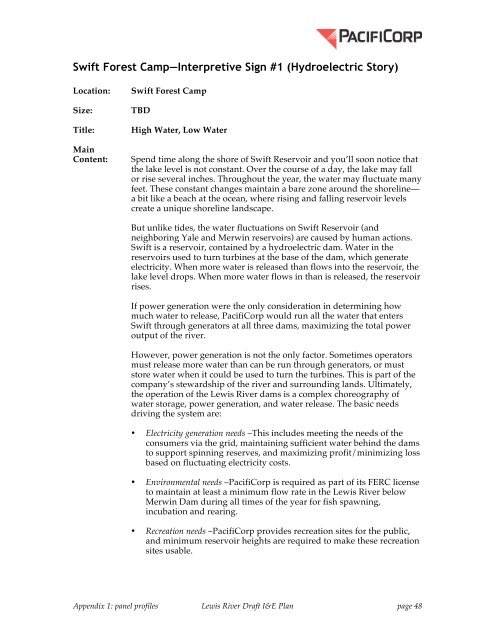The Lewis River Hydroelectric Projects - PacifiCorp
The Lewis River Hydroelectric Projects - PacifiCorp
The Lewis River Hydroelectric Projects - PacifiCorp
Create successful ePaper yourself
Turn your PDF publications into a flip-book with our unique Google optimized e-Paper software.
Swift Forest Camp—Interpretive Sign #1 (<strong>Hydroelectric</strong> Story)<br />
Location:<br />
Size:<br />
Title:<br />
Main<br />
Content:<br />
Swift Forest Camp<br />
TBD<br />
High Water, Low Water<br />
Spend time along the shore of Swift Reservoir and you’ll soon notice that<br />
the lake level is not constant. Over the course of a day, the lake may fall<br />
or rise several inches. Throughout the year, the water may fluctuate many<br />
feet. <strong>The</strong>se constant changes maintain a bare zone around the shoreline—<br />
a bit like a beach at the ocean, where rising and falling reservoir levels<br />
create a unique shoreline landscape.<br />
But unlike tides, the water fluctuations on Swift Reservoir (and<br />
neighboring Yale and Merwin reservoirs) are caused by human actions.<br />
Swift is a reservoir, contained by a hydroelectric dam. Water in the<br />
reservoirs used to turn turbines at the base of the dam, which generate<br />
electricity. When more water is released than flows into the reservoir, the<br />
lake level drops. When more water flows in than is released, the reservoir<br />
rises.<br />
If power generation were the only consideration in determining how<br />
much water to release, <strong>PacifiCorp</strong> would run all the water that enters<br />
Swift through generators at all three dams, maximizing the total power<br />
output of the river.<br />
However, power generation is not the only factor. Sometimes operators<br />
must release more water than can be run through generators, or must<br />
store water when it could be used to turn the turbines. This is part of the<br />
company’s stewardship of the river and surrounding lands. Ultimately,<br />
the operation of the <strong>Lewis</strong> <strong>River</strong> dams is a complex choreography of<br />
water storage, power generation, and water release. <strong>The</strong> basic needs<br />
driving the system are:<br />
• Electricity generation needs –This includes meeting the needs of the<br />
consumers via the grid, maintaining sufficient water behind the dams<br />
to support spinning reserves, and maximizing profit/minimizing loss<br />
based on fluctuating electricity costs.<br />
• Environmental needs –<strong>PacifiCorp</strong> is required as part of its FERC license<br />
to maintain at least a minimum flow rate in the <strong>Lewis</strong> <strong>River</strong> below<br />
Merwin Dam during all times of the year for fish spawning,<br />
incubation and rearing.<br />
• Recreation needs –<strong>PacifiCorp</strong> provides recreation sites for the public,<br />
and minimum reservoir heights are required to make these recreation<br />
sites usable.<br />
Appendix 1: panel profiles <strong>Lewis</strong> <strong>River</strong> Draft I&E Plan page 48
















